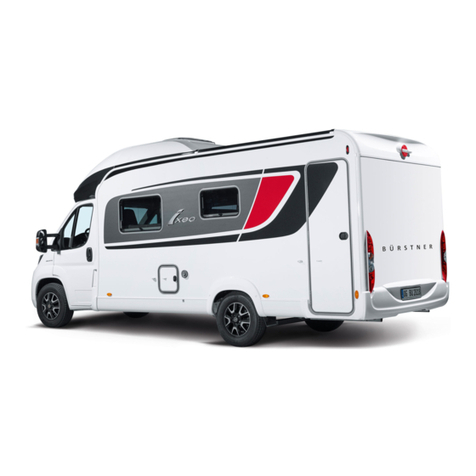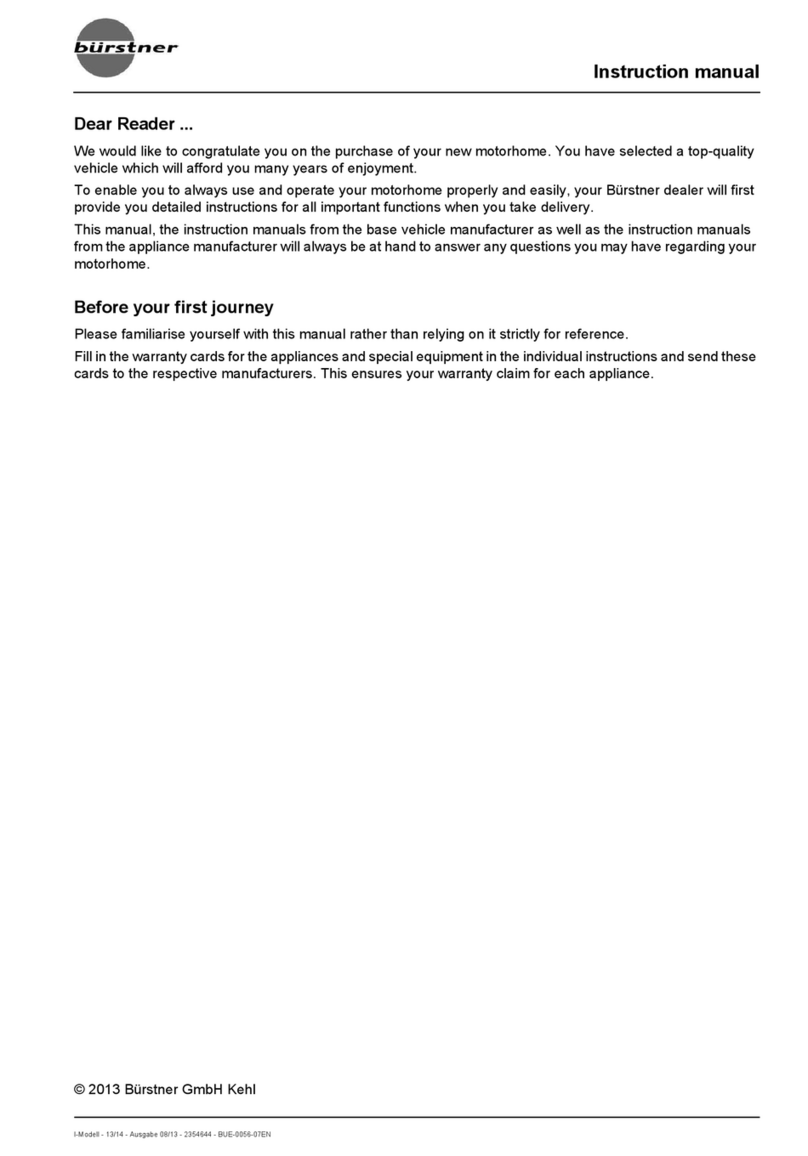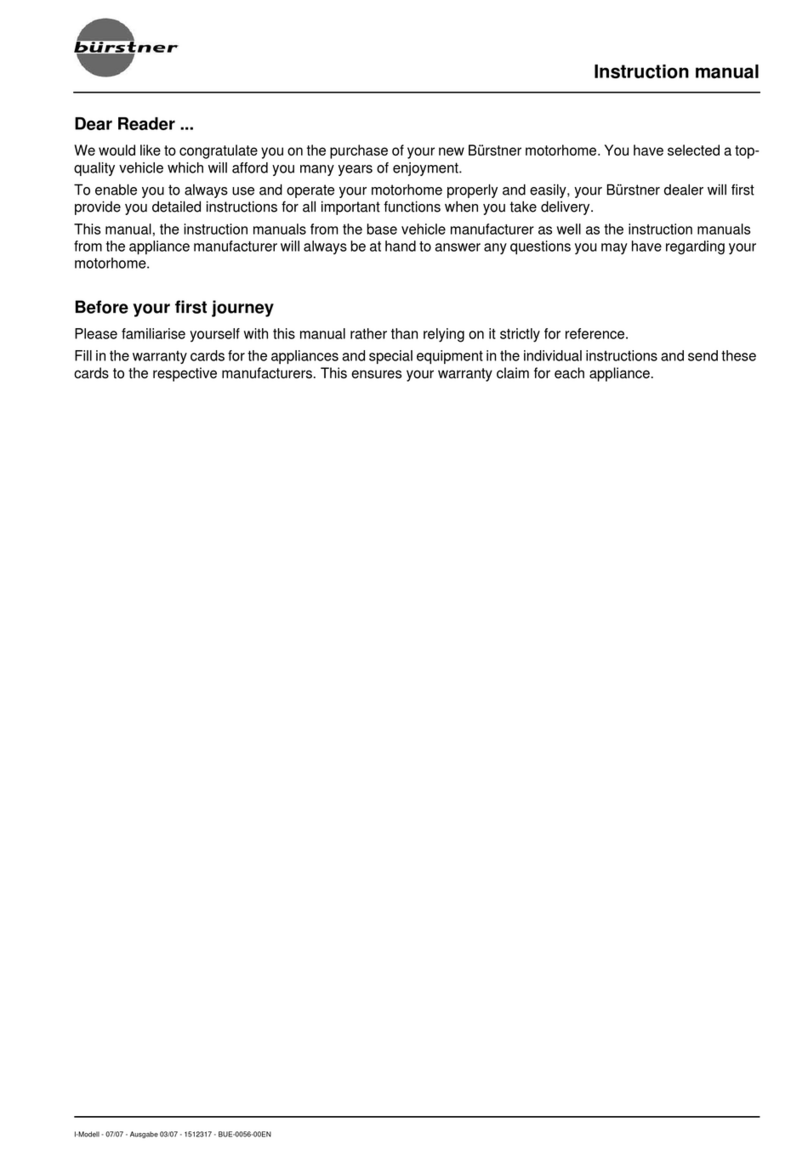
Contents
4I-Modell - 11/12 - Ausgabe 09/11 - 2096165 - BUE-0056-05EN
6.1.7 Window of conversion door
(Hartal Premium)
(partially special equipment) . . . . . . . . 60
6.1.8 Folding insect screen on the
conversion door
(partially special equipment) . . . . . . . . 61
6.2 External flaps . . . . . . . . . . . . . . . . . . . . 61
6.2.1 Flap lock with recessed handle . . . . . . 62
6.2.2 Flap lock, elliptical-shaped. . . . . . . . . . 62
6.2.3 Flap lock with push button . . . . . . . . . . 63
6.2.4 Flap for the 230 V connection,
square . . . . . . . . . . . . . . . . . . . . . . . . . 64
6.2.5 Cap for the drinking water
filler neck . . . . . . . . . . . . . . . . . . . . . . . 64
6.3 Furniture flaps . . . . . . . . . . . . . . . . . . . 65
6.3.1 Furniture flaps with push button. . . . . . 65
6.3.2 Furniture flaps with handle and
push button . . . . . . . . . . . . . . . . . . . . . 65
6.3.3 Furniture flaps with release handle . . . 66
6.3.4 Furniture flaps with release handle . . . 66
6.4 Light switch . . . . . . . . . . . . . . . . . . . . . 67
6.4.1 Entrance area . . . . . . . . . . . . . . . . . . . 67
6.4.2 Interior . . . . . . . . . . . . . . . . . . . . . . . . . 67
6.4.3 Wardrobe light . . . . . . . . . . . . . . . . . . . 68
6.5 Light control . . . . . . . . . . . . . . . . . . . . . 69
6.6 Spotlight . . . . . . . . . . . . . . . . . . . . . . . . 71
6.7 Holder for flat screen . . . . . . . . . . . . . . 71
6.7.1 Holder on the column. . . . . . . . . . . . . . 72
6.7.2 Holder in the TV cabinet . . . . . . . . . . . 72
6.7.3 Holder with jointed arm . . . . . . . . . . . . 73
6.8 Ventilation . . . . . . . . . . . . . . . . . . . . . . 73
6.9 Windows . . . . . . . . . . . . . . . . . . . . . . . 74
6.9.1 Hinged window with rotary hinges . . . . 74
6.9.2 Hinged window with automatic
hinges . . . . . . . . . . . . . . . . . . . . . . . . . 76
6.9.3 Sliding window with lock . . . . . . . . . . . 77
6.9.4 Hinged sunroof with automatic
hinges . . . . . . . . . . . . . . . . . . . . . . . . . 77
6.9.5 Blind and insect screen . . . . . . . . . . . . 78
6.9.6 Blind and insect screen . . . . . . . . . . . . 79
6.9.7 Roman shade and insect screen . . . . . 80
6.9.8 Roman shade and insect screen
(hinged sunroof). . . . . . . . . . . . . . . . . . 80
6.9.9 Roman shades for windscreen,
driver's window and front
passenger's window. . . . . . . . . . . . . . . 81
6.10 Skylights. . . . . . . . . . . . . . . . . . . . . . . . 81
6.10.1 Heki skylight (mini and midi) . . . . . . . . 82
6.10.2 Wind-up skylight
(partially special equipment) . . . . . . . . 83
6.11 Tables . . . . . . . . . . . . . . . . . . . . . . . . . 84
6.11.1 Suspension table with changeable
table leg . . . . . . . . . . . . . . . . . . . . . . . . 84
6.11.2 Fixed table (table-top for folding,
sliding and rotating) . . . . . . . . . . . . . . . 85
6.11.3 Fixed table (extendable table-top) . . . . 86
6.11.4 Fixed table (movable table-top) . . . . . . 87
6.12 Divan adjustment mechanism
(partially special equipment). . . . . . . . .87
6.13 Beds . . . . . . . . . . . . . . . . . . . . . . . . . . .88
6.13.1 Bunk bed . . . . . . . . . . . . . . . . . . . . . . .88
6.13.2 Pull-down bed, manually operated . . . .88
6.13.3 Pull-down bed, electrically
operated (special equipment) . . . . . . . .90
6.13.4 Fixed bed (manual setup). . . . . . . . . . .92
6.13.5 Fixed bed (gas-pressure springs). . . . .93
6.13.6 Fixed bed (adjustable head section). . .94
6.13.7 Fixed bed, electrically adjustable
(partially special equipment). . . . . . . . .94
6.13.8 Widening single beds
(special equipment) . . . . . . . . . . . . . . .96
7 Gas system . . . . . . . . . . . . . . . . . . .97
7.1 General. . . . . . . . . . . . . . . . . . . . . . . . .97
7.2 Gas bottles . . . . . . . . . . . . . . . . . . . . . .98
7.3 Changing gas bottles . . . . . . . . . . . . . .99
7.4 Gas isolator taps. . . . . . . . . . . . . . . . .100
7.5 External gas connection
(special equipment) . . . . . . . . . . . . . .100
7.6 Crash protection unit switching facility
(special equipment) . . . . . . . . . . . . . .101
7.7 DuoControl switching facility
(special equipment) . . . . . . . . . . . . . .103
7.8 Gas alarm system
(special equipment) . . . . . . . . . . . . . .105
8 Electrical system . . . . . . . . . . . .107
8.1 General safety instructions . . . . . . . . .107
8.2 Terms . . . . . . . . . . . . . . . . . . . . . . . . .107
8.3 12 V power supply . . . . . . . . . . . . . . .108
8.3.1 Selector switch for radio
(special equipment) . . . . . . . . . . . . . .108
8.3.2 Starter battery. . . . . . . . . . . . . . . . . . .109
8.3.3 Living area battery . . . . . . . . . . . . . . .110
8.4 Transformer/rectifier (EBL 99) . . . . . .111
8.4.1 Battery cut-off switch . . . . . . . . . . . . .113
8.4.2 Battery selector switch . . . . . . . . . . . .113
8.4.3 Battery monitor . . . . . . . . . . . . . . . . . .113
8.4.4 Charging the battery . . . . . . . . . . . . . .113
8.5 Transformer/rectifier (EBL 220) . . . . .114
8.5.1 Battery separation . . . . . . . . . . . . . . .115
8.5.2 Battery selector switch . . . . . . . . . . . .115
8.5.3 Battery monitor . . . . . . . . . . . . . . . . . .116
8.5.4 Charging the battery . . . . . . . . . . . . . .116
8.6 Panel IT 96-2 . . . . . . . . . . . . . . . . . . .116
8.6.1 12 V main switch . . . . . . . . . . . . . . . .117
8.6.2 V/tank gauge for battery voltage
and water or waste water levels . . . .117
8.6.3 Switch for water pump . . . . . . . . . . . .119
8.6.4 Battery alarm for the living
area battery . . . . . . . . . . . . . . . . . . . .119
8.6.5 12 V indicator lamp. . . . . . . . . . . . . . .119
8.6.6 230 V indicator lamp. . . . . . . . . . . . . .119
8.7 Panel IT 994 . . . . . . . . . . . . . . . . . . . .120

































